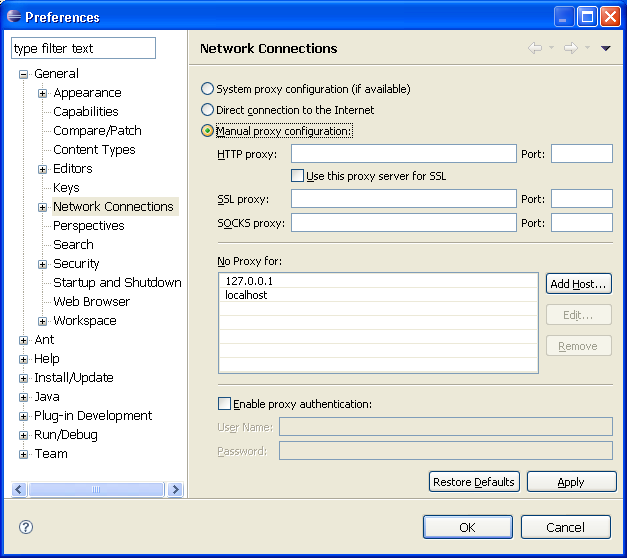 General > Network Connections
preferences page.
General > Network Connections
preferences page.The following sections describe the preferences available on the
 General > Network Connections
preferences page.
General > Network Connections
preferences page.
| Option |
Description |
Default |
|---|---|---|
| Direct connection to the Internet | Enable this option to have all connections to remote systems happen directly without involving a proxy server. | Enabled |
| Manual proxy configuration | Use this option if connections to remote systems should happen through a proxy server. | Disabled |
| HTTP Proxy | Use this option to specify the server and port that is to be used when making HTTP connections. If the port field is empty, the default port of 80 is used. If the "Use this proxy server for SSL" is checked, the HTTP proxy server is used for SSL connections as well. | |
| SSL Proxy | Use this option to specify the server and port that is to be used when making SSL connections. If the port field is empty, the default port of 443 is used. | |
| SOCKS Proxy | Use this option to specify the server and port that is to be used when making SOCKS connections. If the port field is empty, the default port of 1080 is used. [1] | |
| Non-proxied Hosts (No Proxy for) | Use this table to specify, either by name or pattern, which hosts should not use any proxy but instead should always be connected to directly. | |
| Proxy Authentication | Enable this option to specify a user name and password that is to be used when connecting to the proxy server. | Disabled |
The Network Connections preference page

1. The SOCKS proxy support in Java 1.4 had certain limitations. Due to these limitations, the setting of the SOCKS system properties is not performed when a 1.4 VM is used. The SOCKS proxy may still be used by some tooling when running on a 1.4 VM (e.g. CVS). However, users should use a 1.5 (or 5.0) VM if they require full SOCKS proxy support.